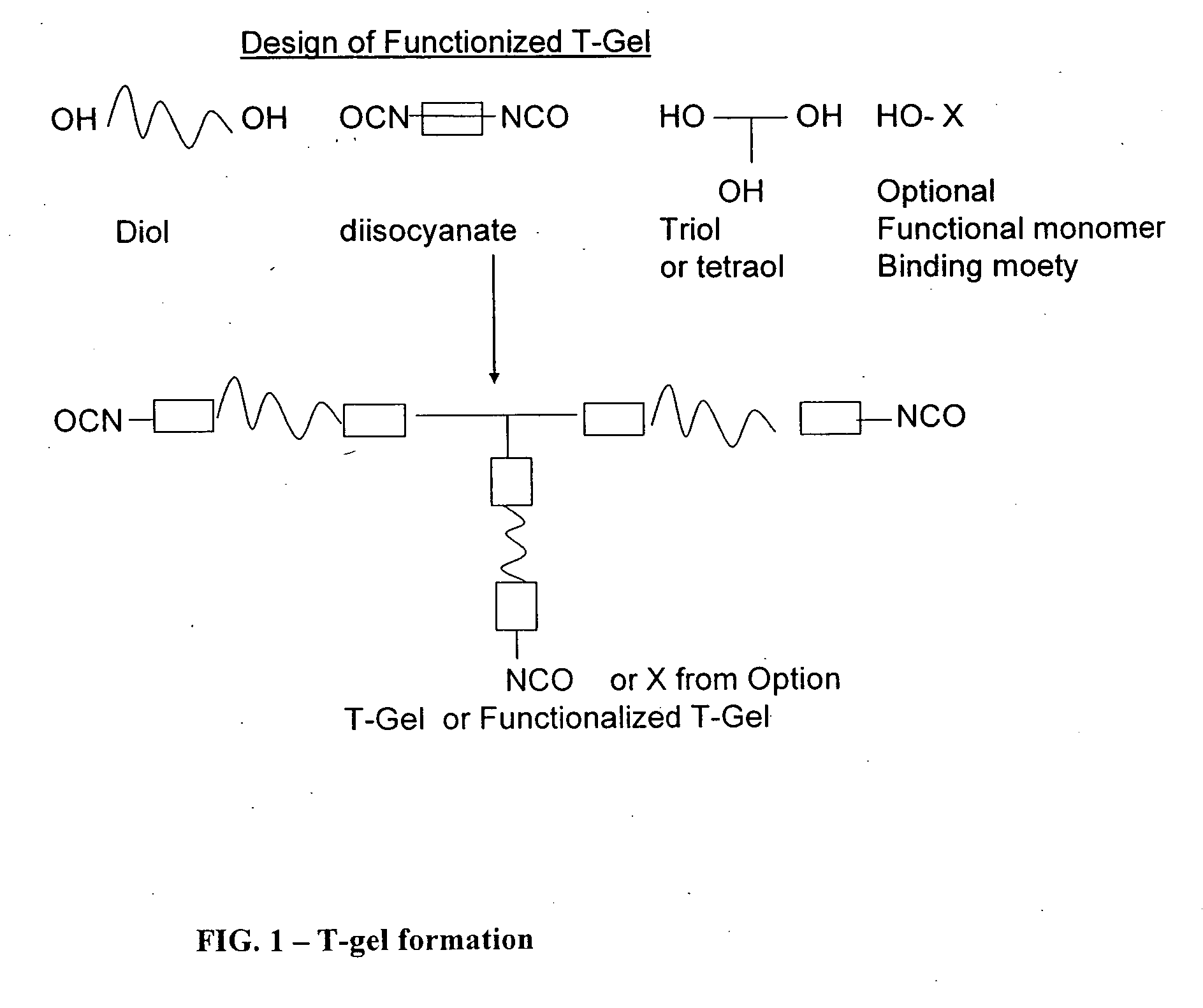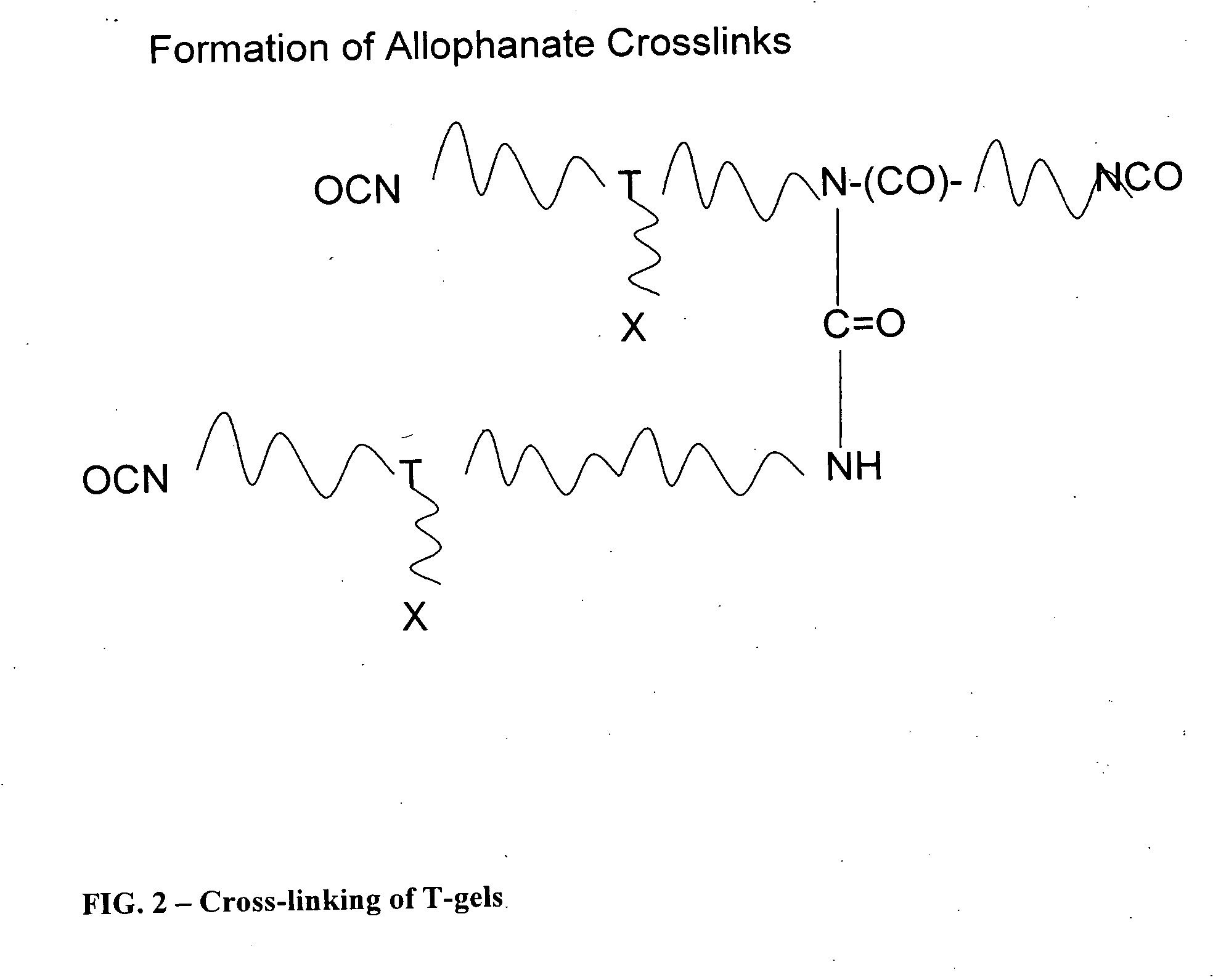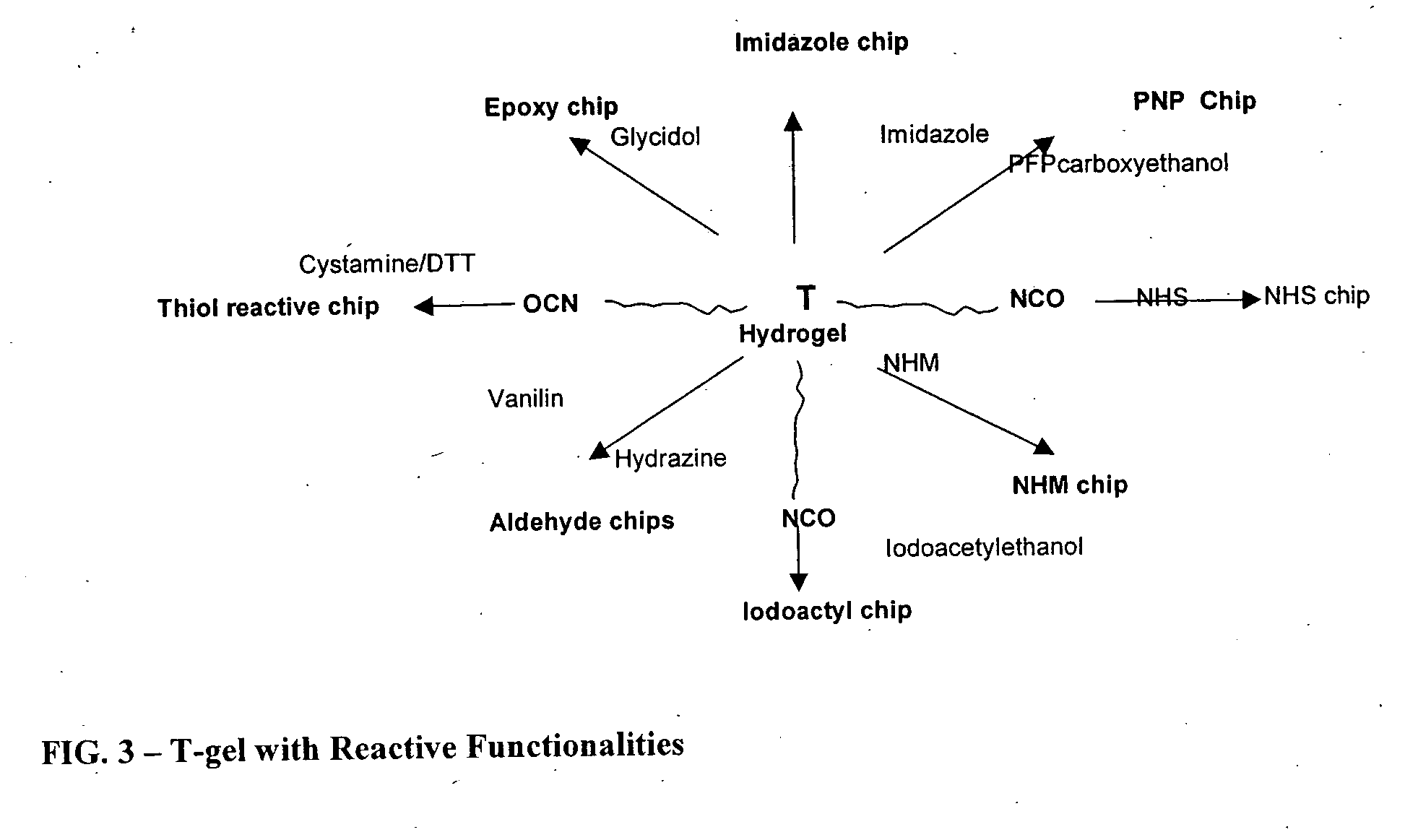Reactive polyurethane-based polymers
a polyurethane-based polymer and polymer technology, applied in the field of reactive polyurethane-based polymers, can solve the problems of difficult if not impossible control of all of these parameters impinging on reproducibility, significant errors in undertaking assays, and poor reproducibility of all parameters from spot to spo
- Summary
- Abstract
- Description
- Claims
- Application Information
AI Technical Summary
Benefits of technology
Problems solved by technology
Method used
Image
Examples
example 1
Non-Functionalized T-Gel
1.1 Preparative Method for a Non-Functionalized Polyurethane Polymer Unit—T-Gel
1.1a PU-400 Isocyante-Terminated Polyurethane from PEG 400
[0227] Toluene di-isocyanate (“TDI”) (1.15 g) was added in one portion to a mixture of poly(ethyleneglycol) (“PEG”) 400 (1.2 g), and trimethylol propane (“TMP”) (0.134 g) in anhydrous dimethylformamide (13 g). The mixture was stirred for 1 h, forming the T-gel polyurethane polymer.
1.1b PU-200 Isocyante-Terminated Polyurethane (T-Gel) from PEG 200
[0228] The procedure was the same as above except PEG 200 (0.55 g) was used instead of PEG 400.
1.1c PU-600 Isocyante-Terminated Polyurethane (T-Gel) from PEG 600
[0229] The procedure was the same as 1.1a above except PEG 600 (1.8 g) was used.
1.1d PU-1000 Isocyante-Terminated Polyurethane from PEG 1000
[0230] The procedure was the same as 1.1a above except PEG 1000 (2.96 g) was used.
1.1e PU-Dihydroxybenzoic Acid (DHBA) Isocyante-Terminated Polyurethane from DHBA
[0231] TDI (1...
example 2
T-Gel with Cationic Exchange Functionalities
2.1 Preparation of a Polyurethane T-Gel Weak Cation Exchange Polymer
2.1a 1,4-Butanediol-3-carboxylic Acid-Based PU Polymer
[0232] The procedures were the same as in Example 1.1a except 1,4-butanediol-3-carboxylic acid (0.41 g) was added instead of PEG 400. The solution was used to prepare WCX chips. Alternatively, some of the 1,4-butanediol-3 carboxylic acid was partially replaced by PEG 200, 400, or 1000.
2.1b Glycolic Acid-Based PU Polymer from T-Gel
[0233] Glycolic acid (4.4 mg) was added to 5% T-gel (1 g) already prepared from example 1.1b. The solution was used to prepare WCX chips. Alternatively, T-gels from any of Examples 1.1a to 1.1 d can be used.
2.2 Preparation of a Polyurethane Strong Cation Exchange Polymer T-Gel
[0234] The procedures are the same as Example 2.1a except 1,4-butanediol-3-sulfonic acid (0.56 g) was added instead of PEG 400. The solution was used to prepare SCX chips. Alternatively, some of the 1,4-butanediol-...
example 3
T-Gel with Anion Exchange Functionalities
3.1 Preparation of a Polyurethane Strong Anion Exchange Polymer
3.1a 1,4-Butanediol-3-trimethylammonium Chloride-Based PU Polymer
[0235] The procedure used to prepare the strong anion exchange polymer are the same as Example 2.1a except 1,4-butanediol-3-trimethylammonium chloride (0.55 g) was added instead of 1,4-butanediol-3-carboxylic acid. Alternatively, some of the 1,4-butanediol-3-trimethylammonium chloride was partially replaced by PEG 200, 400, or 1000.
3.1b Choline Chloride-Based PU Polymer T-Gel
[0236] The preparative method for a choline strong anion exchange polymer was the same as example 2.1b except choline chloride (8 mg) was added to the T-gel instead of glycolic acid. The solution was used to prepare SAX chips. Alternatively, choline chloride can be added to the T-gels from any of examples 1.1a to 1.1d.
PUM
| Property | Measurement | Unit |
|---|---|---|
| time | aaaaa | aaaaa |
| molecular weight | aaaaa | aaaaa |
| molecular weight | aaaaa | aaaaa |
Abstract
Description
Claims
Application Information
 Login to View More
Login to View More - R&D
- Intellectual Property
- Life Sciences
- Materials
- Tech Scout
- Unparalleled Data Quality
- Higher Quality Content
- 60% Fewer Hallucinations
Browse by: Latest US Patents, China's latest patents, Technical Efficacy Thesaurus, Application Domain, Technology Topic, Popular Technical Reports.
© 2025 PatSnap. All rights reserved.Legal|Privacy policy|Modern Slavery Act Transparency Statement|Sitemap|About US| Contact US: help@patsnap.com



